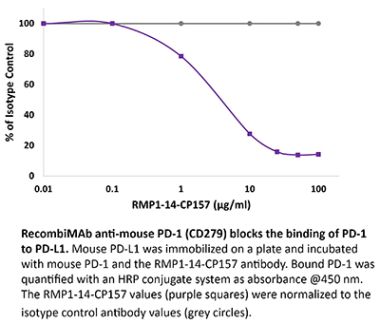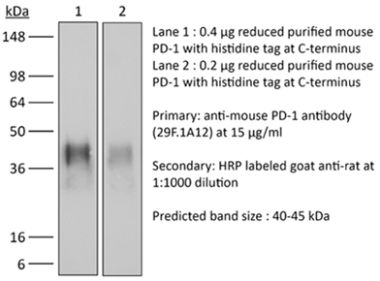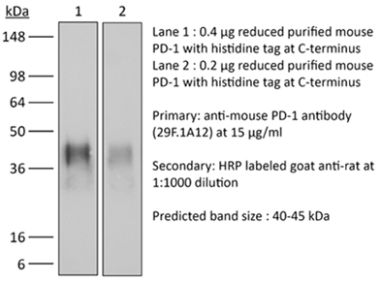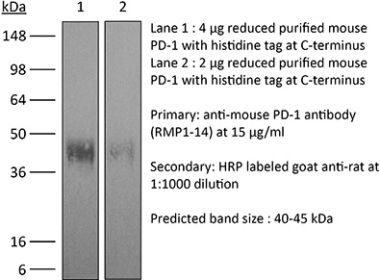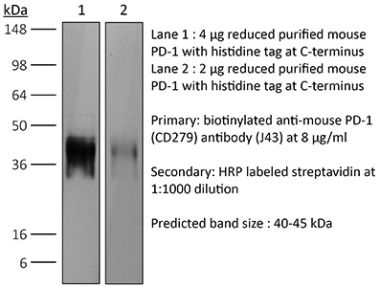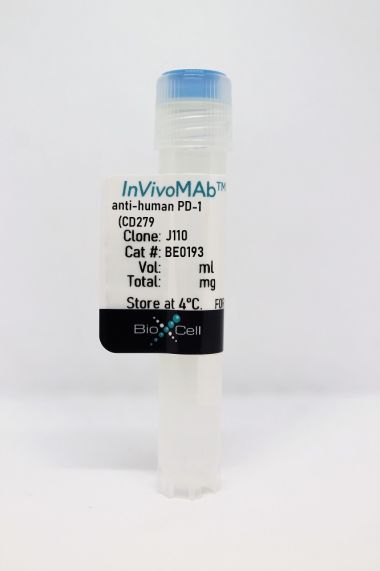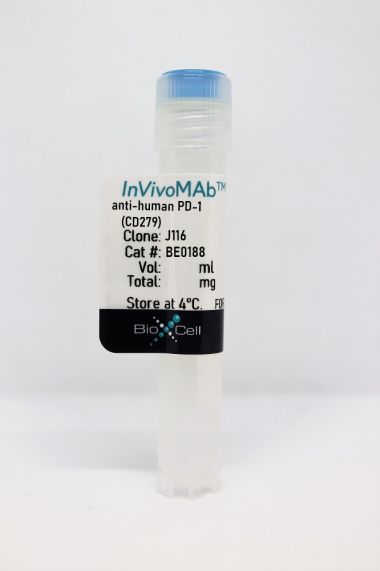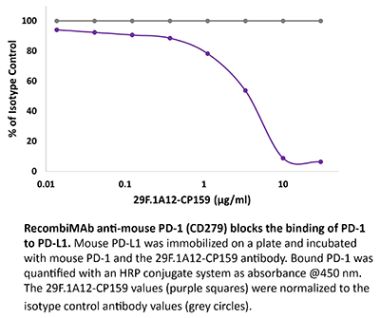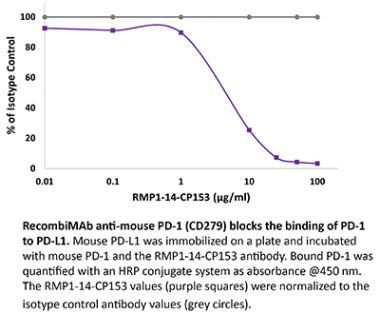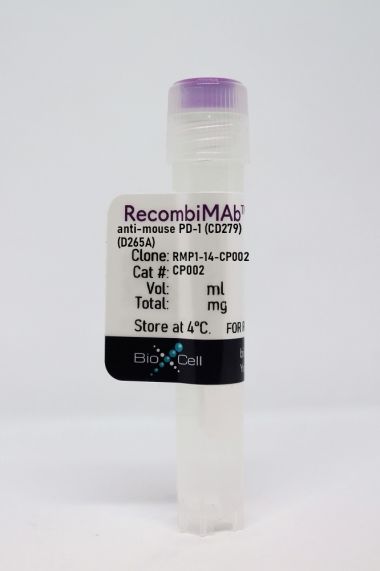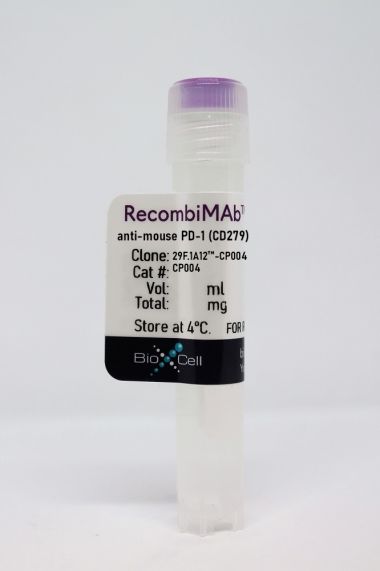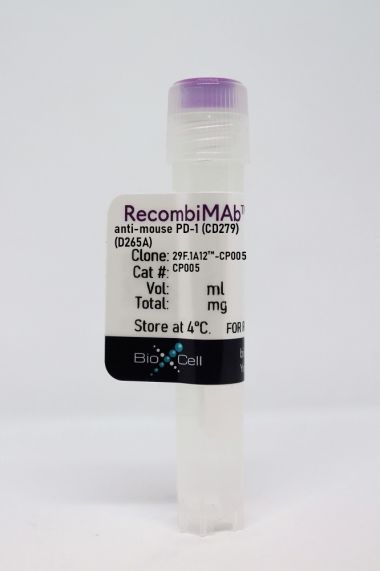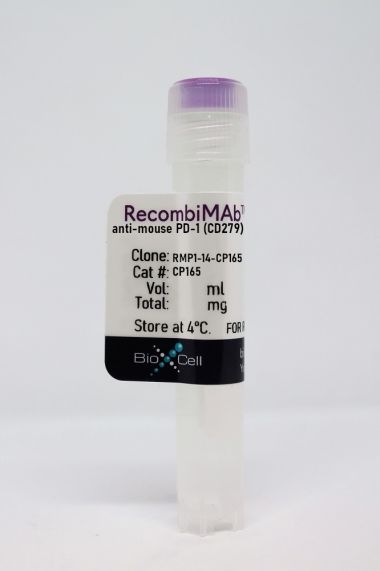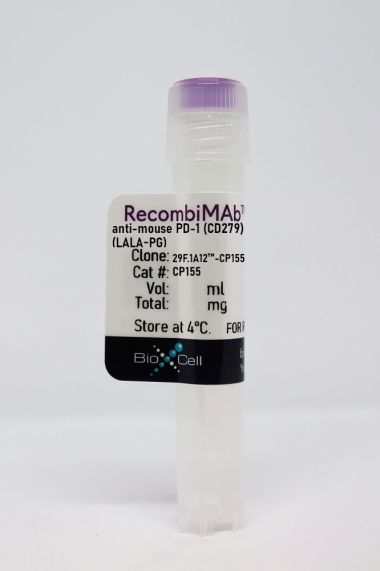InVivoSIM anti-human PD-1 (Pembrolizumab Biosimilar)
Product Details
This non-therapeutic biosimilar antibody uses the same variable regions from the therapeutic antibody Pembrolizumab making it ideal for research use. This Pembrolizumab biosimilar reacts with human PD-1 (programmed death-1) also known as CD279. PD-1 is a 50-55 kDa cell surface receptor encoded by the Pdcd1 gene that belongs to the CD28 family of the Ig superfamily. PD-1 is transiently expressed on CD4 and CD8 thymocytes as well as activated T and B lymphocytes and myeloid cells. PD-1 expression declines after successful elimination of antigen. Additionally, Pdcd1 mRNA is expressed in developing B lymphocytes during the pro-B-cell stage. PD-1’s structure includes a ITIM (immunoreceptor tyrosine-based inhibitory motif) suggesting that PD-1 negatively regulates TCR signals. PD-1 signals via binding its two ligands, PD-L1 and PD-L2 both members of the B7 family. Upon ligand binding, PD-1 signaling inhibits T-cell activation, leading to reduced proliferation, cytokine production, and T-cell death. Additionally, PD-1 is known to play key roles in peripheral tolerance and prevention of autoimmune disease. Induced PD-L1 expression is common in many tumors including squamous cell carcinoma, colon adenocarcinoma, and breast adenocarcinoma. PD-L1 overexpression results in increased resistance of tumor cells to CD8 T cell mediated lysis. PD-L1 overexpression results in increased resistance of tumor cells to CD8 T cell mediated lysis. In experimental models of melanoma, tumor growth can be transiently arrested via treatment with antibodies which block the interaction between PD-L1 and its receptor PD-1. For these reasons anti-PD-1 mediated immunotherapies are currently being used as cancer treatments. Pembrolizumab binds to PD-1 on activated immune cells to selectively block the interaction of PD-1 with its ligands.Specifications
| Isotype | Human IgG4 |
|---|---|
| Recommended Isotype Control(s) | RecombiMAb human IgG4 (S228P) isotype control, anti-hen egg lysozyme |
| Recommended Dilution Buffer | InVivoPure pH 7.0 Dilution Buffer |
| Conjugation | This product is unconjugated. Conjugation is available via our Antibody Conjugation Services. |
| Immunogen | Human PD-1 |
| Reported Applications |
Blocking of PD-1/PD-L signaling Functional assays |
| Formulation |
PBS, pH 7.0 Contains no stabilizers or preservatives |
| Endotoxin |
<1EU/mg (<0.001EU/μg) Determined by LAL gel clotting assay |
| Aggregation |
<5% Determined by SEC |
| Purity |
>95% Determined by SDS-PAGE |
| Sterility | 0.2 µm filtration |
| Production | Purified from cell culture supernatant in an animal-free facility |
| Purification | Protein A |
| RRID | AB_2894731 |
| Molecular Weight | 150 kDa |
| Murine Pathogen Tests |
Ectromelia/Mousepox Virus: Negative Hantavirus: Negative K Virus: Negative Lactate Dehydrogenase-Elevating Virus: Negative Lymphocytic Choriomeningitis virus: Negative Mouse Adenovirus: Negative Mouse Cytomegalovirus: Negative Mouse Hepatitis Virus: Negative Mouse Minute Virus: Negative Mouse Norovirus: Negative Mouse Parvovirus: Negative Mouse Rotavirus: Negative Mycoplasma Pulmonis: Negative Pneumonia Virus of Mice: Negative Polyoma Virus: Negative Reovirus Screen: Negative Sendai Virus: Negative Theiler’s Murine Encephalomyelitis: Negative |
| Storage | The antibody solution should be stored at the stock concentration at 4°C. Do not freeze. |
Recommended Products
in vivo blocking of PD-1/PD-L signaling
Yu W, He J, Wang F, He Q, Shi Y, Tao X, Sun B. (2023). "NR4A1 mediates NK-cell dysfunction in hepatocellular carcinoma via the IFN-γ/p-STAT1/IRF1 pathway" Immunology 169(1):69-82. PubMed
Hepatocellular carcinoma (HCC) is one of the most fatal tumours worldwide and has a high recurrence rate. Nevertheless, the mechanism of HCC genesis remains partly unexplored, while the efficiency of HCC treatments remains limited. The present study analysed the expression of nuclear receptor subfamily 4 group A member 1 (NR4A1) in tumour-infiltrating natural killer (NK) cells derived from both human patients with HCC and tumour-bearing mouse models, as well as the features of NR4A1high and NR4A1low NK cells. In addition, knockout of NR4A1 by CRISPR/Cas9 and adoptive transfer experiments were applied to verify the function of NR4A1 in both tumour-infiltrating NK cells and anti-PD-1 therapy. The present study found that NR4A1 was significantly highly expressed in tumour-infiltrating NK cells, which mediated the dysfunction of tumour-infiltrating NK cells by regulating the IFN-γ/p-STAT1/IRF1 signalling pathway. Knockout of NR4A1 in NK cells not only restored the antitumour function of NK cells but also enhanced the efficacy of anti-PD-1 therapy. The present findings suggest a regulatory role of NR4A1 in the immune progress of NK cells against HCC, which may provide a new direction for immunotherapies of HCC.





